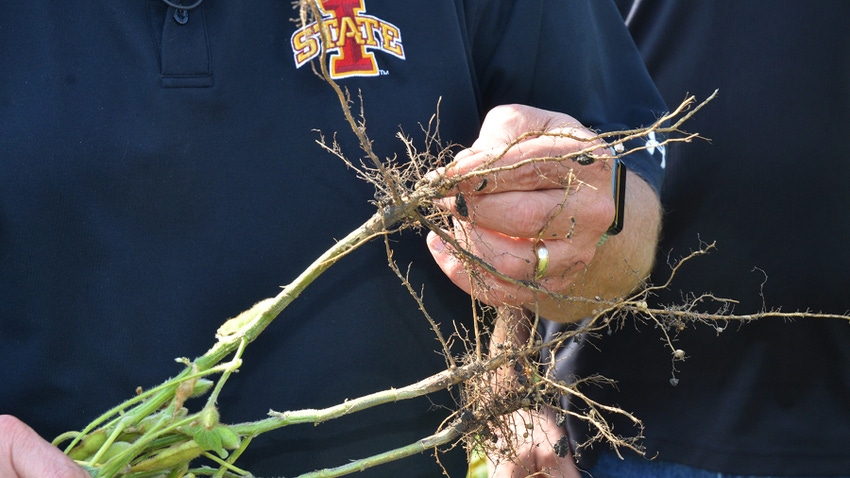January 12, 2024

The soybean cyst nematode is thought to cost soybean producers $1.5 billion annually in North America. A new online resource from the SCN Coalition uses data collected from Iowa State University research to estimate the cost of yield reductions from SCN in individual fields.
The calculator, named the SCN Profit Checker, is available at scnprofitchecker.com. It allows users to provide specific information about individual SCN-infested fields to gauge the possible economic cost of yield loss caused by the nematode.
The tool is based on data from more than 35,000 ISU SCN-resistant soybean variety trial research plots in 180 studies conducted from 2001 to 2020 throughout all nine crop-reporting districts in Iowa. SCN population densities in the plots ranged from very low to very high. The experiments were conducted in fields rented from farmers in locations that had varying soil and local weather conditions. The research was funded primarily by the Iowa Soybean Association.
Using calculator
The calculator can be used for fields known to be infested with SCN and have been sampled for SCN. Also, the calculator is meant to be used with fields where soybean varieties with the PI 88788 SCN resistance trait have been grown.
The user provides the following about the SCN-infested field:
SCN egg population density (eggs per 100 cubic centimeters of soil)
female index of the SCN population in the field on PI 88788 resistance (a percent)
percent sand content of the soil
pH of soil in the field
The calculator asks for this information because these were the major factors affecting yield in the data, which serve as the basis of the calculator. If more than one SCN soil sample was collected from a field to determine SCN egg population densities, the average of the sample results should be entered into the calculator.
The calculator estimates relative yield reduction expressed as a percentage, which can be applied to soybeans grown in any SCN-infested field. Percent yield loss is converted into estimated economic yield loss based on the farmer’s yield expectation for the field and marketing sale price goal (see figure).

The results of the SCN Profit Checker reveal an estimated 19.1% yield loss, which represents a loss of $173.81 per acre based on a 70-bushel-per-acre yield expectation and $13-per-bushel marketing price.
Although the calculator is built from research results in Iowa, the percent yield loss can be used for a range of geographies. Users should be aware that the effects of weather, aspects of the specific soybean varieties grown elsewhere, local soil conditions, and other factors also may have significant effects on yield loss caused by SCN in an individual field. Thus, the output from the calculator should be considered only an estimate of possible yield loss.
There are a few situations in which the calculator should not be used, namely if the SCN egg population density is zero and if the soybean variety grown this season was susceptible or possessed Peking SCN resistance. Also, entering extreme values in the calculator, such as 80,000 eggs per 100 cc of soil, 100% sand, or pH of 10, likely will produce unreasonable yield loss estimates.
What is the female index?
The female index of an SCN population on PI 88788 is determined by an HG type test. The index indicates how well an SCN population is controlled by the PI 88788 source of resistance that is commonly used to breed soybean varieties. Facilities that conduct HG type tests are listed in an article from the SCN Coalition at thescncoalition.com.
When soybean varieties with SCN resistance from PI 88788 initially are used, the SCN populations are controlled well, and female indices typically will be between zero and 10%, indicating 90% to 100% control. In situations where soybean varieties with PI 88788 SCN resistance have been grown repeatedly for numerous years, such as in Iowa, SCN populations evolve to develop high reproduction on PI 88788 resistance and female indices are 50% or greater, indicating that PI 88788 resistance offers reduced control of the nematode.
The reduced effectiveness of resistance leads to greater SCN reproduction, increased egg population densities and greater yield loss.
Once a user selects the state in which the field of interest is located, the calculator automatically provides a default female index for PI 88788 that was provided by a university SCN expert in that state. This allows farmers who do not know the female indices of the SCN populations in their specific fields to use the resource. The default female index value is an educated guess that may be based on limited data.
For Iowa, the default female index is 45, which is the midpoint of the range of female indices currently known for SCN populations in the state. The estimated yield loss of a field determined by the calculator will be most accurate if actual female index values are known and used.
Calculator creation
The calculator was created by the SCN Coalition to show farmers and those who advise them the economic benefit from actively managing SCN.
“Active” SCN management involves:
soil-sampling fields regularly to monitor SCN numbers
growing soybean varieties with differing SCN resistance genes (see ISU Extension publication CROPS 1649 here)
growing soybeans in rotation with nonhost crops such as corn
experimenting with nematode-protectant seed treatments for a yield boost
Meaningful soil samples must be collected to assess SCN population densities in a field to get the most useful estimate of SCN yield loss from the SCN Profit Checker. A recent ICM News article here provides guidelines for collecting soil samples for SCN.
Read more about:
SCNAbout the Author(s)
You May Also Like




